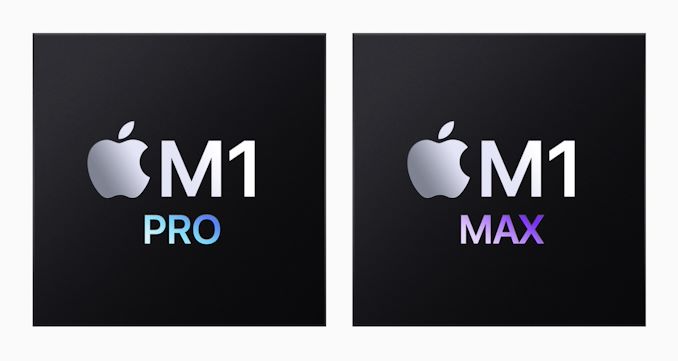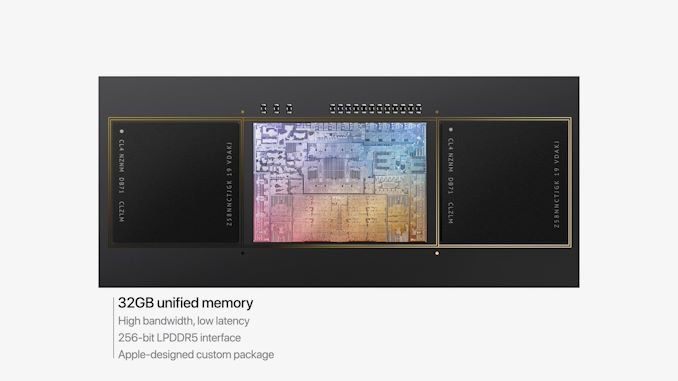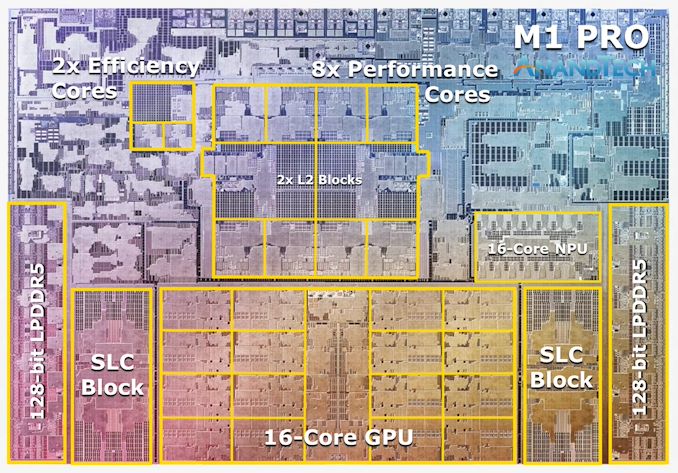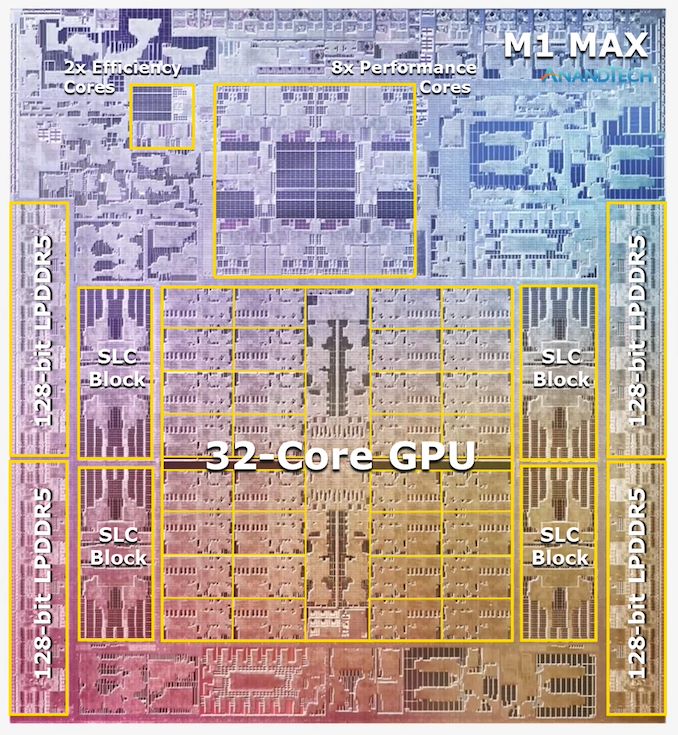Apple's M1 Pro, M1 Max SoCs Investigated: New Performance and Efficiency Heights
by Andrei Frumusanu on October 25, 2021 9:00 AM EST- Posted in
- Laptops
- Apple
- MacBook
- Apple M1 Pro
- Apple M1 Max

Last week, Apple had unveiled their new generation MacBook Pro laptop series, a new range of flagship devices that bring with them significant updates to the company’s professional and power-user oriented user-base. The new devices particularly differentiate themselves in that they’re now powered by two new additional entries in Apple’s own silicon line-up, the M1 Pro and the M1 Max. We’ve covered the initial reveal in last week’s overview article of the two new chips, and today we’re getting the first glimpses of the performance we’re expected to see off the new silicon.
The M1 Pro: 10-core CPU, 16-core GPU, 33.7bn Transistors
Starting off with the M1 Pro, the smaller sibling of the two, the design appears to be a new implementation of the first generation M1 chip, but this time designed from the ground up to scale up larger and to more performance. The M1 Pro in our view is the more interesting of the two designs, as it offers mostly everything that power users will deem generationally important in terms of upgrades.
At the heart of the SoC we find a new 10-core CPU setup, in a 8+2 configuration, with there being 8 performance Firestorm cores and 2 efficiency Icestorm cores. We had indicated in our initial coverage that it appears that Apple’s new M1 Pro and Max chips is using a similar, if not the same generation CPU IP as on the M1, rather than updating things to the newer generation cores that are being used in the A15. We seemingly can confirm this, as we’re seeing no apparent changes in the cores compared to what we’ve discovered on the M1 chips.
The CPU cores clock up to 3228MHz peak, however vary in frequency depending on how many cores are active within a cluster, clocking down to 3132 at 2, and 3036 MHz at 3 and 4 cores active. I say “per cluster”, because the 8 performance cores in the M1 Pro and M1 Max are indeed consisting of two 4-core clusters, both with their own 12MB L2 caches, and each being able to clock their CPUs independently from each other, so it’s actually possible to have four active cores in one cluster at 3036MHz and one active core in the other cluster running at 3.23GHz.
The two E-cores in the system clock at up to 2064MHz, and as opposed to the M1, there’s only two of them this time around, however, Apple still gives them their full 4MB of L2 cache, same as on the M1 and A-derivative chips.
One large feature of both chips is their much-increased memory bandwidth and interfaces – the M1 Pro features 256-bit LPDDR5 memory at 6400MT/s speeds, corresponding to 204GB/s bandwidth. This is significantly higher than the M1 at 68GB/s, and also generally higher than competitor laptop platforms which still rely on 128-bit interfaces.
We’ve been able to identify the “SLC”, or system level cache as we call it, to be falling in at 24MB for the M1 Pro, and 48MB on the M1 Max, a bit smaller than what we initially speculated, but makes sense given the SRAM die area – representing a 50% increase over the per-block SLC on the M1.
The M1 Max: A 32-Core GPU Monstrosity at 57bn Transistors
Above the M1 Pro we have Apple’s second new M1 chip, the M1 Max. The M1 Max is essentially identical to the M1 Pro in terms of architecture and in many of its functional blocks – but what sets the Max apart is that Apple has equipped it with much larger GPU and media encode/decode complexes. Overall, Apple has doubled the number of GPU cores and media blocks, giving the M1 Max virtually twice the GPU and media performance.
The GPU and memory interfaces of the chip are by far the most differentiated aspects of the chip, instead of a 16-core GPU, Apple doubles things up to a 32-core unit. On the M1 Max which we tested for today, the GPU is running at up to 1296MHz - quite fast for what we consider mobile IP, but still significantly slower than what we’ve seen from the conventional PC and console space where GPUs now can run up to around 2.5GHz.
Apple also doubles up on the memory interfaces, using a whopping 512-bit wide LPDDR5 memory subsystem – unheard of in an SoC and even rare amongst historical discrete GPU designs. This gives the chip a massive 408GB/s of bandwidth – how this bandwidth is accessible to the various IP blocks on the chip is one of the things we’ll be investigating today.
The memory controller caches are at 48MB in this chip, allowing for theoretically amplified memory bandwidth for various SoC blocks as well as reducing off-chip DRAM traffic, thus also reducing power and energy usage of the chip.
Apple’s die shot of the M1 Max was a bit weird initially in that we weren’t sure if it actually represents physical reality – especially on the bottom part of the chip we had noted that there appears to be a doubled up NPU – something Apple doesn’t officially disclose. A doubled up media engine makes sense as that’s part of the features of the chip, however until we can get a third-party die shot to confirm that this is indeed how the chip looks like, we’ll refrain from speculating further in this regard.














493 Comments
View All Comments
web2dot0 - Tuesday, October 26, 2021 - link
You just made his case. 😂melgross - Monday, October 25, 2021 - link
We’re all ready seeing optimized software from Blackmagic, and others. Blackmagic is claiming anything from 2 times to over 7 times performance gains in Resolve 17.4 with the 32 core Max.Apple also has a power mode that we can access which will turn the fans to max level for extra performance. I’m looking to try that when my 16” comes in a few days. I wonder if that feature was tested, as it wasn’t mentioned.
Gaming, well, yeah. Over the decades most ports were bad. I don’t have any thought that the ones tested here were much better. Then running under Rosetta 2, as good as it is, isn’t helping.
daveinpublic - Monday, October 25, 2021 - link
Huh, nice way to hijack the top comment.name99 - Monday, October 25, 2021 - link
So nothing changes.Gamers have always hated Apple. Doesn't change.
Developers have been uninterested in Apple. Probably doesn't change.
None of this matters to Apple, or most of its customers. Doesn't change.
*Perhaps* Apple will make some attempt to grow Arcade upwards, but honestly, why bother? Almost all the ranting about gaming HW in threads like this is trash talk and aspirational; it does no translate into purchases, certainly not of Apple HW, and usually not of Wintel HW. It's no different from the sort of comments you might read on a Maserati vs Ferrari comment board -- and as uninteresting and unimportant to either the engineers at both companies, or most of the *actual* customers.
web2dot0 - Tuesday, October 26, 2021 - link
Developers love MacBookPro what are you talking about?!?mlambert890 - Tuesday, October 26, 2021 - link
He's talking about *game developers* targeting MacOS. Not that in developers in general tend to like MacBooks (although certainly not Windows developers obviously)TheinsanegamerN - Tuesday, October 26, 2021 - link
Apple developers love macbook pros. The rest of the world sees them for the overpriced shiny facebook machines they've become. Gone are the days of the 2010 era tank macbook pros that lasted forever, chromebooks have better build quality and longer lifespans then modern apple products.steven4570 - Friday, October 29, 2021 - link
"The rest of the world sees them for the overpriced shiny facebook machines they've become. "Not really
Hrunga_Zmuda - Monday, October 25, 2021 - link
It's not M1X. There are two chips, M1 Pro and M1 Max.I'm guessing that next year, the entry level chips will be M2 and the big boys will be M2 Pro and M2 Max.
TedTschopp - Monday, October 25, 2021 - link
The money in the gaming space is in mobile gaming, not in AAA gaming, and Apple is the leader in Mobile Gaming Revenue. So the classic pattern here would be for them to leverage themselves from the leader in the low-end market into a leader in the high-end market.And with their first attempt at a gaming class machine, they came out with something in the first quartile. Next year, when the M2 Pro and Max, my guess is that they will be accelerating faster then their competition as their development and design processes have been designed to out compete mobile competitors, not desktop competitors like Intel and NVidia.